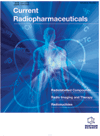-
s [18F]Amylovis as a Potential PET Probe for β-Amyloid Plaque: Synthesis, In Silico, In vitro and In vivo Evaluations
- Source: Current Radiopharmaceuticals, Volume 12, Issue 1, Apr 2019, p. 58 - 71
-
- 01 Apr 2019
Abstract
Background: Alzheimer’s disease (AD) is the most common form of dementia. Neuroimaging methods have widened the horizons for AD diagnosis and therapy. The goals of this work are the synthesis of 2-(3-fluoropropyl)-6-methoxynaphthalene (5) and its [18F]-radiolabeled counterpart ([18F]Amylovis), the in silico and in vitro comparative evaluations of [18F]Amylovis and [11C]Pittsburg compound B (PIB) and the in vivo preclinical evaluation of [18F]Amylovis in transgenic and wild mice. Methods: Iron-catalysis cross coupling reaction, followed by fluorination and radiofluorination steps were carried out to obtain 5 and 18F-Amylovis. Protein/Aplaques binding, biodistribution, PET/CT Imaging and immunohistochemical studies were conducted in healthy/transgenic mice. Results: The synthesis of 5 was successful obtained. Comparative in silico studies predicting that 5 should have affinity to the Aβ-peptide, mainly through π-π interactions. According to a dynamic simulation study the ligand-Aβ peptide complexes are stable in simulation-time (ΔG = -5.31 kcal/mol). [18F]Amylovis was obtained with satisfactory yield, high radiochemical purity and specific activity. The [18F]Amylovis log Poct/PBS value suggests its potential ability for crossing the blood brain barrier (BBB). According to in vitro assays, [18F]Amylovis has an adequate stability in time. Higher affinity to Aβ plaques were found for [18F]Amylovis (Kd 0.16 nmol/L) than PIB (Kd 8.86 nmol/L) in brain serial sections of 3xTg-AD mice. Biodistribution in healthy mice showed that [18F]Amylovis crosses the BBB with rapid uptake (7 %ID/g at 5 min) and good washout (0.11±0.03 %ID/g at 60 min). Comparative PET dynamic studies of [18F]Amylovis in healthy and transgenic APPSwe/PS1dE9 mice, revealed a significant high uptake in the mice model. Conclusion: The in silico, in vitro and in vivo results justify that [18F]Amylovis should be studied as a promissory PET imaging agent to detect the presence of Aβ senile plaques.


